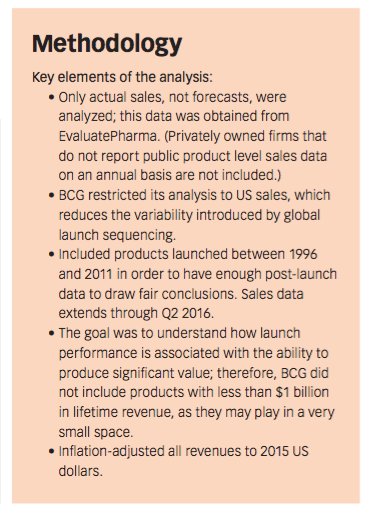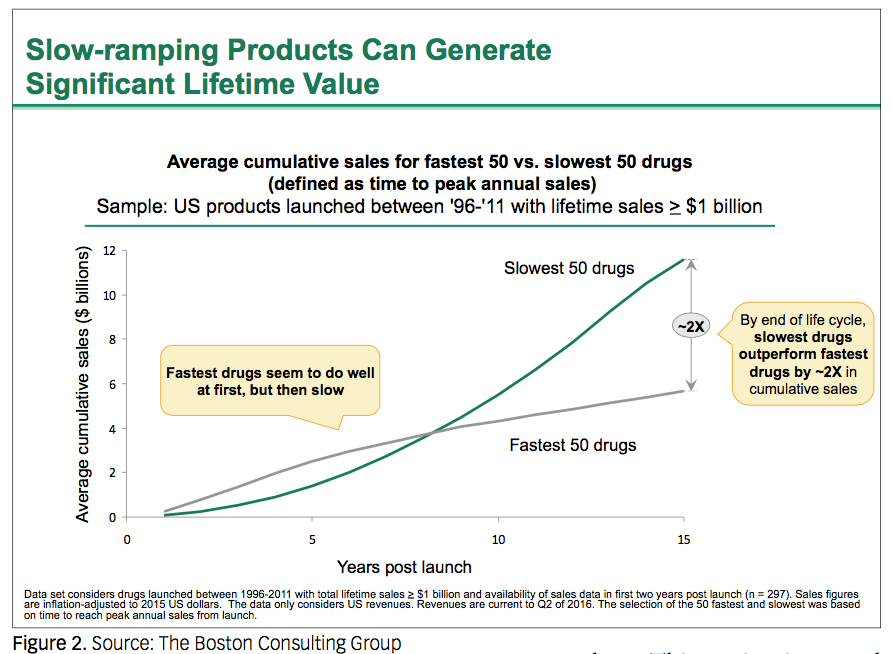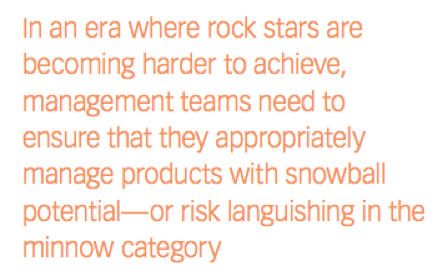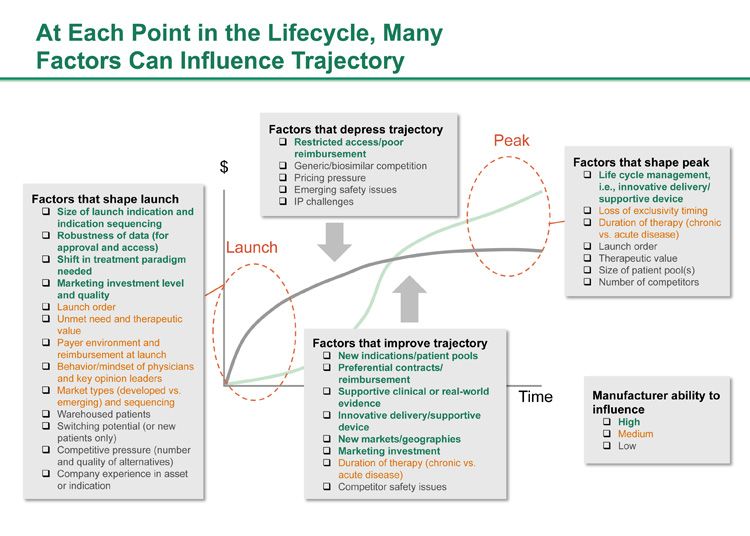Launch for Long-Term Success
Study examines why a pharma brand’s early sales are not a trusted predictor for total lifetime value-it’s about driving waves of growth.
Is a fast launch the only path to a high-value product? Surprisingly, the answer is no. A study by The Boston Consulting Group looks at why a pharma brand’s early sales are not a trusted predictor for total lifetime value-it’s about driving waves of growth.
In the biopharmaceutical industry, the common wisdom holds that sales in the first few months after a product launch provide a good indication of a product’s destiny. When companies dream of launching a blockbuster, they envision a drug that launches fast, catches on quickly, and generates massive returns in its first year-and for the next 10 years. But is a fast launch the only path to a high-value product? Surprisingly, the answer is no.
The Boston Consulting Group (BCG) conducted a comprehensive analysis of approximately 300 biopharmaceutical products that launched in the US between 1996 and 2011, and followed their results through mid-2016, which allowed at least five years of post-launch data (see methodology box for additional details). We found that early sales are not a good predictor for total value created over the product’s lifetime. Among drugs with more than $10 billion in lifetime revenue, there are more that started out slowly than
Study methodology (click to enlarge)

there are ones that shot out of the gate (See Figure 1 below). A large number of products that have a fast launch (65%) go on to create tremendous value; a fast launch is clearly desirable. But when we analyze all the products that generated significant sales over their lifetimes ($10 billion or more), most (55%) started out slowly. In short, all is not lost if a launch is slow-the key to generating significant value is a long life.
To demonstrate the value of a long life, BCG selected the 50 products that reached their peak the fastest and compared them to the 50 that reached it the slowest. The products slowest to reach their peak created double the value over their lifetime than those that ramped up the fastest (see Figure 2 at bottom). Being fast out of the gate is not necessarily the key to long-term value creation. Products that manage to stay on the market and continue to grow throughout their long life generate significantly more value, even if they experienced a slow start.

Although we can’t yet make judgments about lifetime value for products that have launched since 2012, it’s interesting to note that between 2012 and 2015, we observed the same proportion of fast launches to slow launches as was seen between 1996 and 2011. In both periods, approximately 12% of launches were “fast,” meaning they generated $800 million or more (in 2015 dollars) in their first 18 months on the market. This may come as a surprise, as many in the biopharma industry have expressed concern that launches have slowed in recent years. That may yet turn out to be the case, as payer and regulatory pressures continue to mount. It’s also possible that expectations for launches are ratcheting higher as firms seek growth, resulting in higher expectations and, therefore, a higher number of missed targets.
What’s more, BCG found that the rate of fast launches in oncology is slower than average (about 7% of cancer drugs have fast launches), but many oncology products go on to produce tremendous value, despite slow starts.

Simmer or stall?
What allows some slow starters to grow and thrive over a long period of time? And how can analysts and launch teams differentiate between a slow starter with blockbuster potential and a slow starter that will never break out?
Straight lines and S-curves. No two pharmaceuticals perform exactly alike, but product revenue curves typically fall into one of the following four profiles, classified according to a drug’s early results and the lifetime value:
- Minnows: These drugs have a slow launch and fail to grow. Many products fall into this category, but it’s not a desirable place to be.
- Shooting stars: These drugs have a fast launch but peter out and lose momentum over time. This is fairly uncommon, but it has been seen with biopharmaceutical products that are eclipsed by a competitor like Incivek or face a safety issue like Vioxx.
- Rock stars: This is the typical blockbuster drug, like Advair, Avastin, Lipitor, or Zyprexa. These products launch fast, drive strong sales, and produce significant value over time. Many biopharma commercial teams have this in mind when they picture a successful launch-a straight line that keeps climbing up and up.
- Snowballs: These drugs have slower starts but ultimately create tremendous value. Products like Enbrel, Herceptin, Lantus, Plavix, Remicade, Rituxan, and Singulair fit this profile. Snowballs will produce revenue curves with an S-shape, rather than the traditional straight line trajectory.
The slower growth trajectory of a snowball may be an advantage over the long run, but only if the product continues to grow over time; otherwise, it’s just a minnow. So, how do launch teams and analysts differentiate the snowballs from the minnows?
ID’ing the snowballs
We identified three features characterizing the slow on-ramp products that ultimately produce significant value later in life.
Products that require a paradigm shift: Some new drugs introduced into the market require clinicians or patients to adapt to a new treatment pattern or protocol-and that takes time. But once physicians and patients adapt to the new model, the drug can gain traction very quickly. For example, when the breast cancer therapy Herceptin was brought to market, it was among the first products to require biomarker testing to identify the patients that would benefit from the drug. This testing increased the effectiveness of Herceptin, but it also took years for clear testing guidelines to be released. There was confusion about the best testing methodology and how to interpret results, and uptake was slow. Once testing guidelines solidified and impressive survival data was published, uptake increased significantly, and Herceptin generated enormous value. Similarly, it took time for physicians to move from solely treating with oral

therapies to prescribe injectable biologics for the treatment of rheumatoid arthritis. Once physicians recognized the unique benefits of the biologics, drugs like Enbrel, Humira, and Remicade transformed into blockbusters.
Products with expanded indications over time: In today’s regulatory environment, it’s becoming increasingly rare for a new product to be approved with a very broad indication. Approvals will typically match the specific patient pools that were in the clinical trials. This is especially common in oncology, but it applies to other therapeutic areas as well, and it can contribute to less initial value. If a product receives approval for only one narrow indication (for relapsed or refractory patients, for example), it takes time to conduct additional trials in order to gain approval for its use on other types of patients (such as first-line patients). Drugs that can gradually gain approval for additional indications-or make the case for broader use with strong real-world evidence post-launch-will likely expand into much larger patient pools over time.
Products that lead to longer duration therapy: When a product is first approved, the optimal duration of therapy is not always well-defined. But a drug can prove over time that its benefits extend over a much longer time period than originally anticipated. Gleevec is a good example. Used to treat chronic myeloid leukemia (CML), it had a slow launch given that CML is a rare form of cancer that affects just 5,000 to 8,000 patients each year. But Gleevec transformed a fatal disease into a manageable, chronic condition. Patients with a life expectancy of less than five years were able to live for decades, provided that they continued on the therapy. The drug was also approved for additional indications, including gastrointestinal stromal tumors, acute lymphocytic leukemia, and other blood malignancies. By extending the duration of therapy, Gleevec ultimately generated enormous revenue.
It’s also worth noting that payers are increasingly contributing to a slow on-ramp for new biopharmaceuticals. New products with higher prices, larger patient pools, and potentially longer treatment durations put pressure on payer budgets. In some cases, payers are responding by placing new products onto less advantaged tiers; adding restrictive utilization management criteria (such as step-throughs or prior authorization requirements); and demanding larger discounts on products. While these hurdles can contribute to a slow launch, payer access restrictions can be overcome by products that demonstrate superior clinical value.
Implications for launch teams and analysts
While these findings offer good news for biopharmaceutical companies in an era where rock stars are becoming harder to achieve (though they still exist, as we’ve seen with Harvoni, Keytruda, Opdivo, and Sovaldi), management teams need to ensure that they appropriately manage products with snowball potential-or risk languishing in the minnow category.
At each point in the product’s lifecycle-from the initial launch to peak sales-companies have critical opportunities to influence a product’s success. The key is to anticipate factors that will affect a product’s uptake and manage its lifecycle to shape a strong trajectory (see Figure 3).
Figure 3. Source: The Boston Consulting Group

To help snowballs create maximum value over the long term, manufacturers need a targeted strategy that includes four critical components.
Be clear on product differentiation and which patients and physicians the product can win. In a crowded market, launch teams need to be specific and precise about which patients their product is appropriate for so they can articulate this to the right physicians. Teams need solid answers to the following questions:
- Have we adequately clarified how the new product differs from competitors and what unmet need it addresses? What space will it own in the treatment paradigm?
- Which patient types are appropriate-initially, and then as physicians gain experience?
- Which physicians disproportionately treat those patients and will see the value of the product?
- What physician and patient behaviors will need to change in order to drive uptake? How do we support that change and how long will it take?
- What are the implications of our positioning for our forecast?
Craft a forward-thinking reimbursement strategy. Clearly, the reimbursement landscape has changed significantly in recent years. Payers are placing more restrictions on which biopharmaceuticals they will cover and excluding certain drugs from formularies, even innovative products with best-in-class efficacy. And many physicians are reluctant to prescribe a medicine if their patients face meaningful payer restrictions. The burden is falling on biopharma companies to prove value. In this climate, launch teams need to ask:
Do we have a clear, tested narrative that explains the product’s value, supported by data?
- Are we planning early enough to generate the outcomes data we need to make the case to payers around the product’s value?
- What innovative contracting and reimbursement strategies can we implement to accelerate product uptake?
- What is the optimal pricing strategy per country and across countries to optimize revenue, given potential access restrictions and price referencing?
Ensure smart implementation. Launches can get lost in the checklist. Teams may strive to be so comprehensive in their launch planning that they fail to identify and prioritize the three or four factors most critical to a product’s long-term success. To support smart and adaptive launch, teams must consider:
- Which two or three aspects of our launch will play the largest role in shaping performance for this product-and have we done everything we can to address them?
- Is our implementation plan designed to encourage the necessary behavior changes we need to drive?
- Do we have a process to track our launch readiness that will ensure we hit milestones but won’t waste resources on low-value activities?
- How will the product be perceived by patient advocates, care givers, and other influencers, including the media and analysts? Do we need to clarify our message to these stakeholders?
Plant the seeds for second-wave growth. Launch teams tend to focus on what happens with a product right out of the gate, but it pays to plan for the slower uptake that characterizes snowballs. To plant the seeds for long-term growth, companies need to consider the following:
- Have we determined the key barriers to accelerated uptake and addressed those?
- Do we have a robust lifecycle plan?
- Are we collecting and leveraging real-world outcomes data that can help further drive uptake and demonstrate value?
Commitment-minded
Many of today’s biopharma launches fail to meet analysts’ expectations in their first year on the market-and slow starts create a great deal of anxiety in an industry challenged by patent cliffs, more generics and biosimilars coming to market, and intense scrutiny from payers. While many in the industry tend to assume that skyrocketing sales the first few months after launch represent the best possible outcome, BCG found that many products that reached their peak more slowly ultimately outperformed those that reached their peak more quickly.
Launch teams have an opportunity to create extraordinary value for their companies, shareholders, and patients by nurturing high-impact, slow-to-develop products-but it requires a smart strategy and a willingness to play the long game.
Romney Resney is a Senior Partner and Managing Director and Erica Carlisle is a Principal, both in The Boston Consulting Group’s San Francisco office. Alex Aboshiha is a Partner and Managing Director with BCG in Los Angeles. Steve Waddell is a Partner and Managing Director in the firm’s Chicago office. Authors thank Chris Aakre and Colin Salko for contributions.

Trump: 'Major Tariff' on Pharmaceuticals Coming Soon
Published: April 9th 2025 | Updated: April 9th 2025“We’re going to tariff our pharmaceuticals, and once we do that, they are going to come rushing back into our country," President Donald J. Trump said during a Tuesday night dinner in Washington.
The Misinformation Maze: Navigating Public Health in the Digital Age
March 11th 2025Jennifer Butler, chief commercial officer of Pleio, discusses misinformation's threat to public health, where patients are turning for trustworthy health information, the industry's pivot to peer-to-patient strategies to educate patients, and more.
Navigating Distrust: Pharma in the Age of Social Media
February 18th 2025Ian Baer, Founder and CEO of Sooth, discusses how the growing distrust in social media will impact industry marketing strategies and the relationships between pharmaceutical companies and the patients they aim to serve. He also explains dark social, how to combat misinformation, closing the trust gap, and more.
Applying Porter’s Five Forces to Portfolio Management in Pharmaceutical R&D: A Strategic Roadmap
March 17th 2025The increasing costs and complexity of R&D in the pharmaceutical industry have necessitated the adoption of strategic portfolio management to optimize resource allocation and enhance competitive advantage.




















